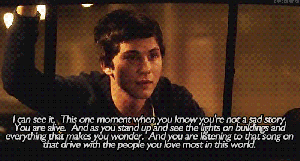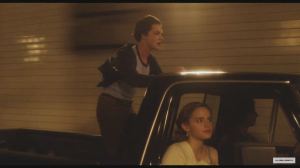I really enjoyed this unit. It gave me a chance to study something that interested me and that I would enjoy! Learning in this way is I think very valuable – I was able to direct myself in the way I wanted to explore Film Study and how I would present my work. I loved that we were given so much freedom and I really liked the scene I analysed. If I could start again, I would have used class time more effectively. Usually I got a lot done working independently, but as it was self-directed, I found myself sometimes distracted! Initially I was going to create a Prezi to show my work but I found this really difficult to operate. So instead I used WordPress, which was still a good learning experience as I’d never created a blog before. I think this was a very clear and appealing way to present it. If I was to teach an aspect of my work to another Year 10 student, I would explain to them how film techniques work, what they are and how they can have an influence over audiences. I would then let them watch a scene, and see if they can pick out different production values the director has used in the film for a deliberate reason.
Final Scene – Charlie’s Last Letter
Watch the scene I am analysing here:

-charlie’s last letter-
Costumes
In this scene, costumes have been used simply to represent the casual everyday clothes of the characters. However, they do reveal elements of their personalities to the audience. Sam’s costume is a bright blue dress and white cardigan – symbolic of her fun character and efforts to turn from her reputation. Patrick wears black pants and a loud ‘retro’ shirt, somewhat reflecting his outrageousness and charm. Charlie is costumed in a simple T-shirt and hoodie with jeans. Being such a complex character, the costume is a contrast to the struggles he continues to cope with. It does however symbolise his sometimes shy and quiet personality.
Lighting
The lighting in this scene is bright and golden, creating a joyful mood and evoking happiness in the audience. The tunnel which the friends drive through is lit up very bright – symbolic of their growth as characters throughout the film, having finally reached the end of their journey. Charlie, Sam and Patrick’s faces are all lit brightly, which allows the audience to connect with the happiness they are feeling and their reflections on how they have changed. This lighting creates an image of hope and reflects the importance of their friendship. It also emphasises the idea of heading towards the light at the end of the actual and figurative tunnel.
Casting
Emma Watson (Sam)
Director Stephen Chbosky said Emma Watson was ‘just right’ for the role of Sam. A character trying to move past her reputation as someone who let herself be used sexually, it’s the passion Emma Watson had that lead him to casting her. Even though Watson could not relate any of her own ‘superficial’ experiences to the character, she could connect with her on a level outside her own life. Watson portrays Sam as outgoing, fun and sometimes outrageous, but also reveals her deeper and more serious side. She is able to easily express her vulnerabilities and innermost feelings to he audience through her acting. In this scene, Watson conveys the joy Sam feels driving through the tunnel and is able to show how she has been changed throughout the film through new friendships.
Ezra Miller (Patrick)
Chbosky said Ezra Millr played the part of Patrick ‘perfectly’. As a person, the director found Miller to be warm and funny, with the right confidence to play the role. Miller conveys Patrick’s charismatic and over the top personality throughout the film. The character is gay, but Miller doesn’t let him be a victim for one second – he embraces the character in all his exuberance and plays him with fearlessness and strength. In this scene, Miller is able to show Patrick’s journey and his mesmerised happiness as he drives through the tunnel with his friends.
Logan Lerman (Charlie)
Logan Lerman had a difficult job of holding the screen and centering the film, whilst playing the recessive and quiet role of Charlie. However his underrated performance was completely accurate – he didn’t portray Charlie as a completely depressing character but as one who was able to find strength in those around him once he found the place where he belonged. Lerman easily conveyed Charlie’s deepest thoughts to the audience, and encouraged them to sympathise with the character. In this scene, Lerman is able to show Charlie’s sheer joy in driving through the tunnel and his journey from the beginning of the film. He is able to evoke hope and inspiration in the audience through his acting and portraying the way he copes with his experiences.
Camera Angles and Shots
The camera angles used in the tunnel sequence focus heavily on the faces of the characters, including mostly medium close ups. This gives the audience an insight into what the character’s are feeling and emphasises their bewilderment with the tunnel and how much it means in their friendship. As the friends drive through the tunnel, the camera pans out to reveal a long shot of the tunnel. This symbolises the characters’ journeys throughout the film and points towards the bright futures ahead of them now that they have each other. This shot evokes a sense of hope in viewers and is inspiring. This scene is the perfect end to the film, showing the friends finally reaching ‘the light at the end of the tunnel’.
Music and Sound
Charlie narrates the scene, as he does many other scenes throughout the film, as if he were writing a letter to the audience. This narration is beautifully written and allows an element of insightfulness and depth in what the character is feeling. The background music behind the narration is light and twinkling and compliments the narration perfectly. At the end of the narration, Charlie’s voice cuts out and David Bowie’s Heroes swells as the friends exit the tunnel. Heroes is really an anthem for the friends and for the whole film – symbolising their growth, the beauty of friendship, and how life ‘gets better’. This combination of music is uplifting and emotes a feeling of inspiration, happiness and hope.
‘Heroes’ – David Bowie: www.youtube.com/watch?v=Tgcc5V9Hu3g
Visuals and Setting
In this sequence, the trio of friends (Charlie, Sam and Patrick) are catching up after the few months Sam has been away. They drive through a tunnel while listening to ‘the song’ (David Bowie’s Heroes), an experience which has played a major role in their friendship and become a sort of ritual. Charlie sits in the back of the truck, reflecting on his growth during the past year of his life, and coming to appreciate how lucky he is that he has found these amazing friends. He leans in and kisses Sam, and then stands up in the back of the truck, arms outstretched and grinning. As the wind ruffles his hair he realises he has reached the best moment of his life – a moment where he finally belongs – and a moment where he believes he is completely ‘infinite’. The image of the tunnel represents the protagonist’s growth throughout the film. The movie’s director, Stephen Chbosky, said that “the tunnel scene is a symbolic rebirth”, and is a clear reflection of Charlie’s journey as a person and a friend.
Context
Based on the novel written by Stephen Chbosky, The Perks of Being a Wallflower tells the story of 15-year-old Charlie (Logan Lerman), an endearing and naive outsider. The introvert freshman is taken under the wings of two seniors, Sam and Patrick (Emma Watson and Ezra Miller), who welcome him to the real world. The film sees Charlie coping with first love, the suicide of his best friend, and his own mental illness while struggling to find a group of people with who he belongs.
High school is a time full of awkwardness, trials, successes, failures, and most of all, growing up. No matter what someone’s background is, the teenage years are ones of growth and discovery. The Perks of Being a Wallflower, directed and screen written by Stephen Chbosky, portrays these experiences in a relatable and moving way which creates a lasting impression and perspective on the teenage experience.
One scene that shows the overall excellence of film techniques used in The Perks of Being a Wallflower is the final scene, where the three friends drive through a tunnel. Together, the narration, music, cinematography and many other factors create a scene that sends chills across your skin in how beautiful and simple it is. The tunnel scene effectively uses film techniques to appeal to the audience’s emotions and encourage them to feel as if they are involved in the film and personally connected with the characters and their experiences.








